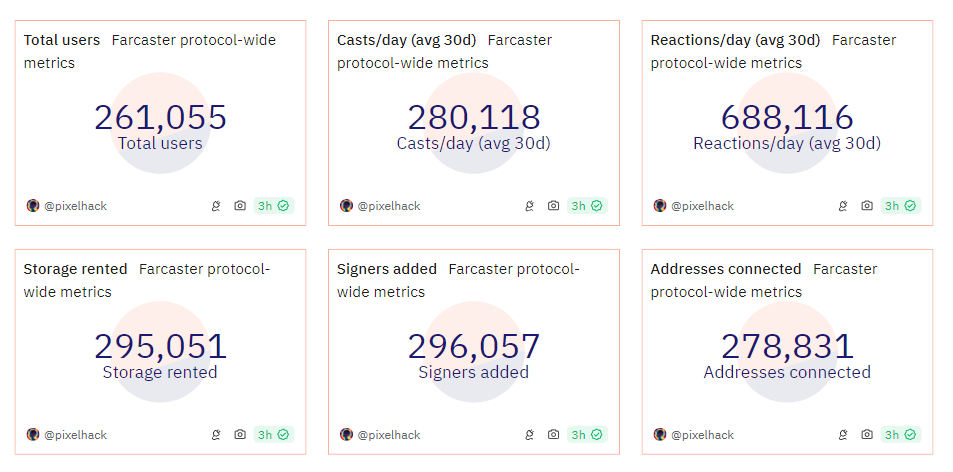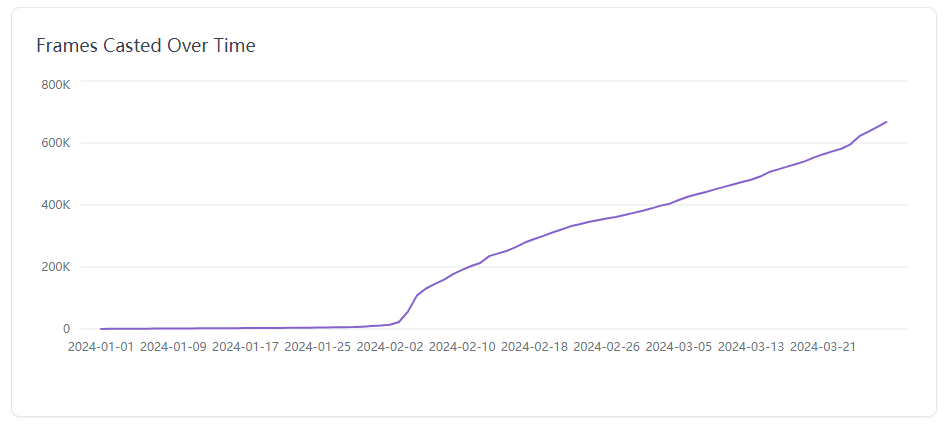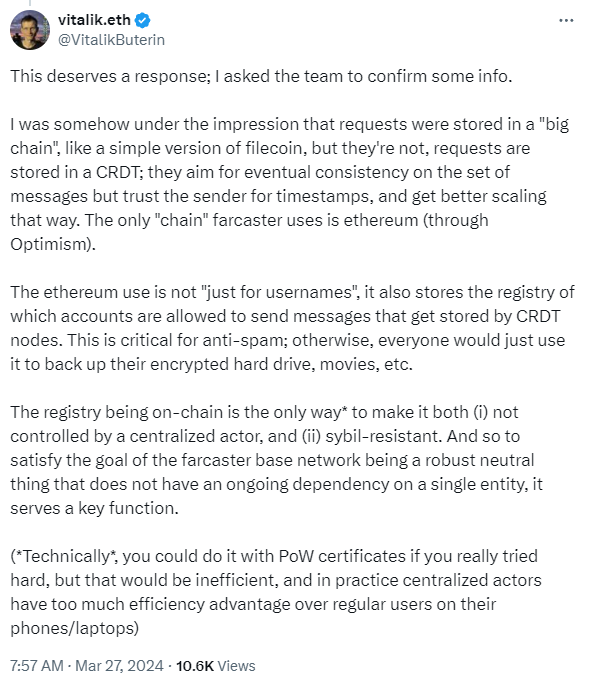About to complete financing valued at US$1 billion, will the decentralized social track be completely different because of Farcaster?
- WBOYWBOYWBOYWBOYWBOYWBOYWBOYWBOYWBOYWBOYWBOYWBOYWBforward
- 2024-04-03 14:50:26941browse
In the field of encryption, decentralized social platforms are trying to break through the monopoly of giants. Most projects have difficulty attracting users. For example, Friend.tech user activity dropped by 97%. But Farcaster is different. It was founded by former Coinbase engineer Dan Romero and received US$30 million in investment led by a16z in 2022. Since 2024, daily active users have increased by more than 10 times, attracting Ethereum founder Vitalik to publish an exclusive article.
On March 31, 2022, Bloomberg reported that Farcaster developer Merkle Manufactory was about to complete a round of financing valued at US$1 billion, led by Paradigm. In July 2022, Merkle completed US$30 million in financing led by a16z.
As of April 1, the total number of Farcaster users reached 261,055, with an average of 280,118 posts per day and a cumulative income of US$902,125.

This article will provide an in-depth analysis of how Farcaster has risen rapidly in the blockchain field and highlighted its value in the competition with its technological innovation and data performance.
With multiple functional innovations, Farcaster is clearly different from other decentralized social protocol applications
Farcaster is a decentralized social network protocol. Compared with similar competing products, its innovations are The features are as follows:
The Frames feature launched by Farcaster optimizes the interactive experience and greatly enriches the user interactive experience of the platform by allowing developers to create interactive and embeddable posts for their audiences. Users can participate in more forms of activities, including minting NFTs, participating in games to receive rewards, and even purchasing goods directly through Farcaster’s client Warpcast. This was unimaginable on the previous Web2 social platform.
Farcaster adheres to the principle of decentralization to ensure that communication between users is not restricted by any intermediary. This not only means that users have complete control over their identity and data, but also means that developers can build truly free social network applications without any third-party restrictions. This also means that users have full control over their identity and data, and developers do not have to worry about any third-party restrictions when developing. Therefore, Farcaster is the concept of building a truly free social network application and is also the development direction of social networks in the future.
Data transparency and user control are one of the functions that the Web2 platform must provide. Parallel to other social protocols such as Lens, Farcaster provides users with absolute control over their data identity by storing their data on a decentralized network, linked to the user’s Ethereum account. This kind of transparency and control is something that Web2 platforms cannot provide.
Diverse clients and features: Leveraging open protocols such as Farcaster, developers have built a range of engaging clients and features that enhance user experience and increase multi-device accessibility of content. These innovations are not limited to Farcaster's flagship client, but include Phaver, Orb and other specialized clients, each providing users with a unique social experience.
Mining data, posting long articles, and giving many rewards, Farcaster community activity continues to rise
In the crypto world, the challenge of building and maintaining an active community is particularly significant. This problem is effectively solved on Farcaster. Farcaster has successfully attracted more than 260,000 users, and even in the face of other hot events in the industry, such as the Frame craze, the platform's user activity and daily interaction volume have remained stable. Behind this achievement is Farcaster's unique community "atmosphere" and participation mechanisms. These mechanisms are completely different from the profit-seeking motives of common encryption applications, and focus more on promoting real and in-depth communication.
By digging deeper into open data, we can see unique patterns of interaction within the Farcaster community. Some 38% of users have asked questions on the platform, which are often more profound and encourage more dialogue and discussion, accounting for 6% of all posts. And 64% of the posts are in the form of replies, which shows that Farcaster community members like to interact and communicate.
In terms of content publishing, Farcaster encourages long-form content, which is positively correlated with user engagement, that is, longer posts tend to get more likes and shares. The popularity of long-form content, despite the platform’s character limit per post, shows the appeal of depth and detail to Farcaster users.

The tipping culture is also one of Farcaster’s unique features, with $DEGEN as the main tipping currency. More than 37,000 users participated in interactions related to $DEGEN, with 16% of votes containing "$DEGEN", highlighting the generosity of the Farcaster community and the prevalence of tipping culture.

Farcaster’s success reflects a core philosophy: deep community participation is far better than superficial interaction. Open and analyzable underlying protocols facilitate this engagement, providing valuable insights into the development of decentralized social media platforms. As Farcaster continues to grow, it sets the standard for maintaining an active and engaged community culture.
V God endorses the Farcaster platform, so the project team can sit back and relax once and for all?
With the rise of Web3 social media platform Farcaster, there has been intense public discussion surrounding the authenticity and effectiveness of its use of blockchain technology. Web3 critic Liron Shapira questioned Farcaster's blockchain application cases, pointing out that most of its technical implementations are not blockchain in nature, but only use blockchain technology for username distribution. In this regard, Ethereum co-founder Vitalik Buterin defended it, emphasizing that Farcaster’s real benefits in providing a decentralized state machine are not as simple as Shapira stated.
Vitalik clarified that Farcaster’s information is not stored in a blockchain in the traditional sense, but uses CRDT (conflict-free copy data type) to store information, with the purpose of not sacrificing scalability. , to achieve eventual consistency of the message set. At the same time, he also emphasized the key role of Ethereum in the Farcaster ecosystem, especially the importance of anti-spam and protecting network neutrality.

Vitalik’s response reveals how Farcaster solves the scalability challenges faced by traditional blockchains through technological innovation while ensuring user control and decentralization principles. . His defense not only highlights Farcaster’s deep understanding of the potential of decentralized social networks, but also points out the flexibility and diversity of applications of Web3 technology in practice.
In summary, although Farcaster’s technical implementation is different from traditional blockchain projects in some aspects, it plays an important role in exploring new paths for decentralized social media platforms. By combining CRDT with Ethereum, Farcaster not only improves the scalability of the network, but also ensures decentralization of the network and user control. Does this mean we need to redefine the boundaries of blockchain applications to include such innovative practices?
The above is the detailed content of About to complete financing valued at US$1 billion, will the decentralized social track be completely different because of Farcaster?. For more information, please follow other related articles on the PHP Chinese website!
Related articles
See more- PHP implements blockchain technology
- Implementing online social network platform using WebMan technology
- Java development experience sharing from scratch: building social network applications
- A quick look at blockchain technology: Is it just Bitcoin?
- Magic Eden and Yuga Labs jointly launch the Ethereum NFT market! Royalties will be enforced

